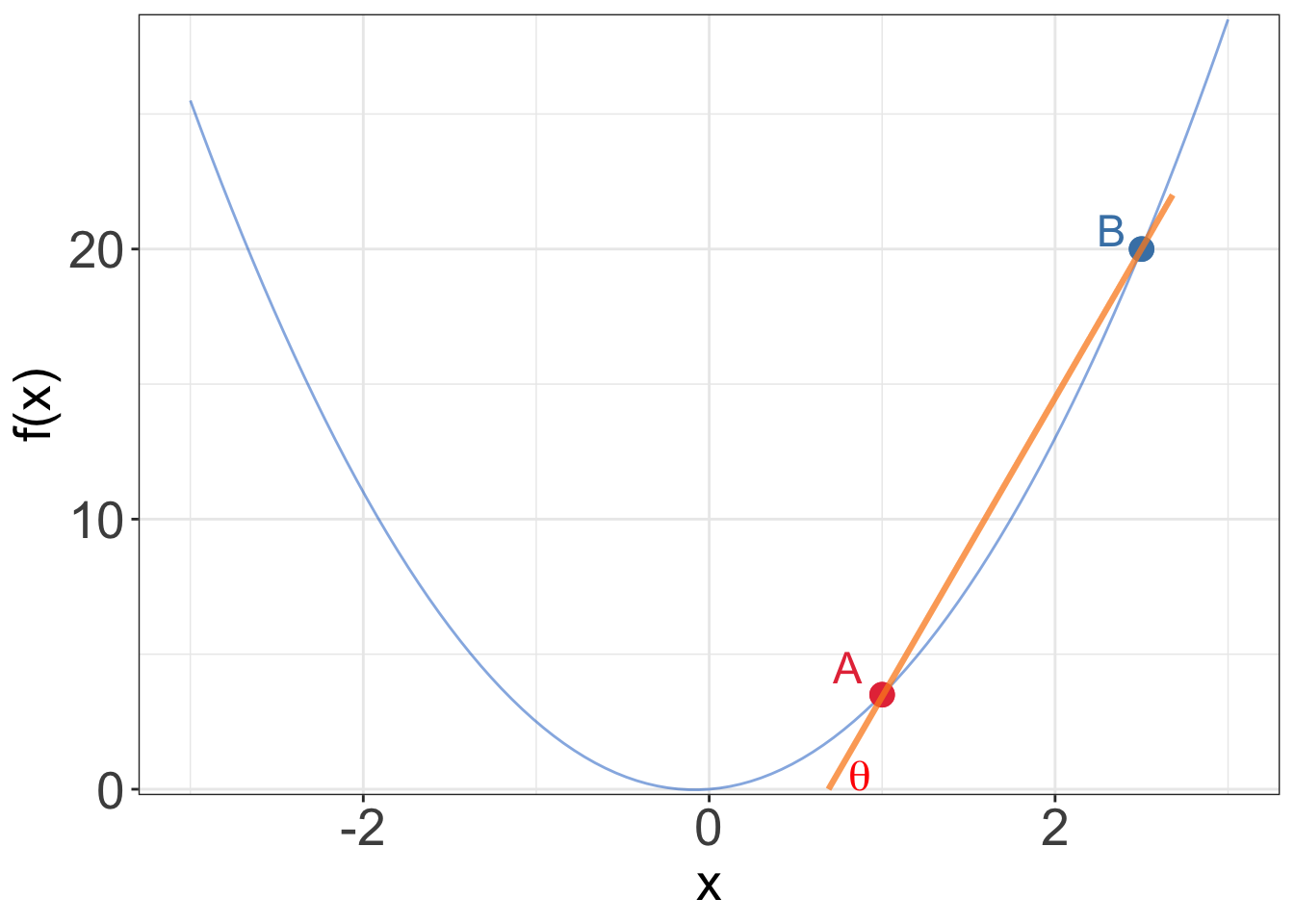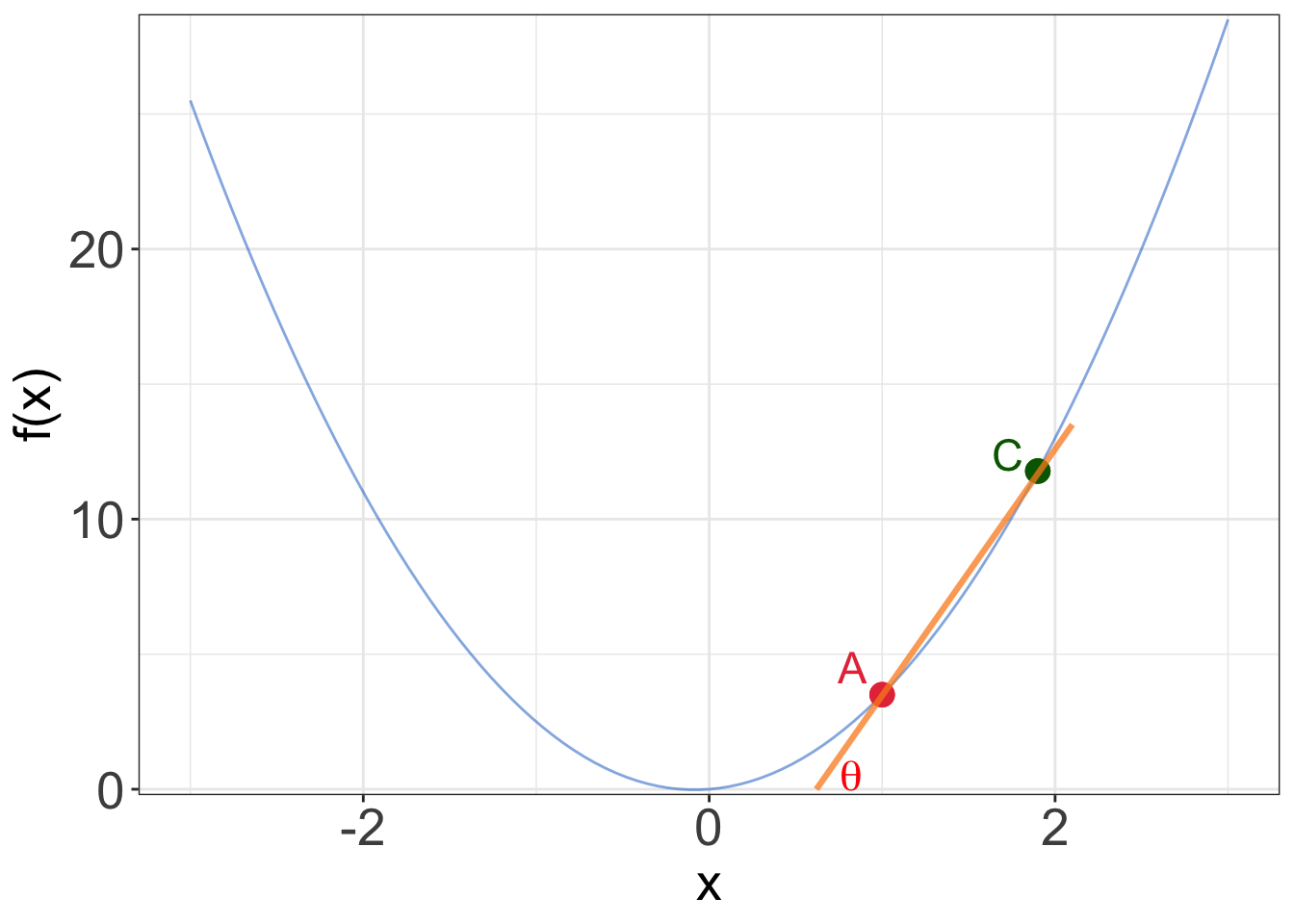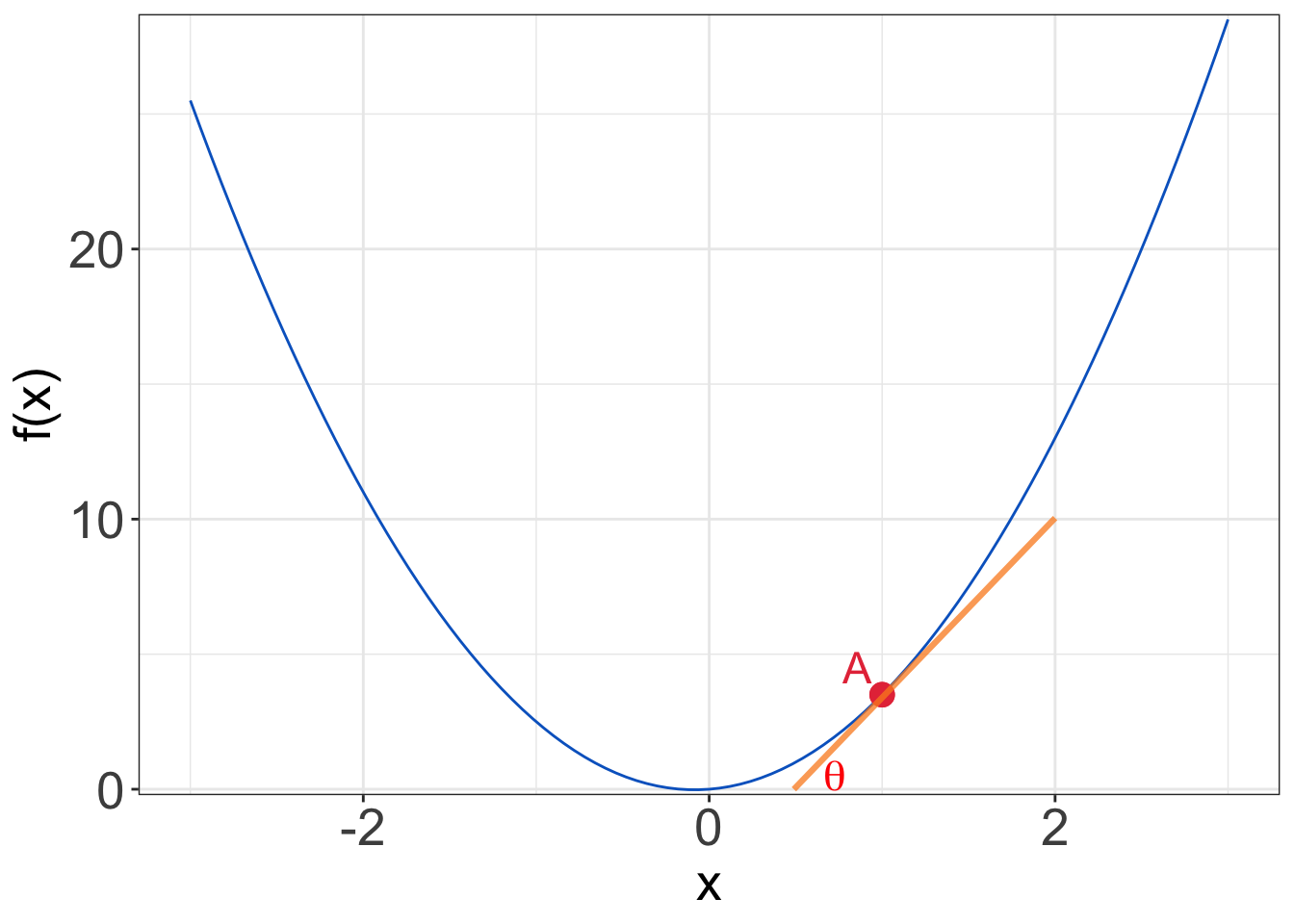Differentiation
1 The idea of differentiation
Differentiation is used to analyze the rate at which a function changes with respect to one of its variables at a given point.
Let \(f(x)\) be a function of \(x\) that is represented graphically in Figure 1.
The line segment connecting the points \(A\) and \(B\) on the curve is known as the
chord(Figure 1a).The gradient (i.e., slope) of the
chordis defined as the ratio of the change in \(y\) to the change in \(x\) between points \(A\) and \(B\) and is equal to \(\tan \theta\).- \(\displaystyle \text{Gradient of the chord} = \tan \theta= \frac{\Delta y}{\Delta x} = \frac{f(x_B) - f(x_A)}{x_B - x_A}\).
Assume that the point \(B\) moves closer and closer to the point \(A\) on the curve (\(B\) becomes \(C\), Figure 1b)until it coincides with \(A\) (Figure 1c).
In Figure 3c, the chord becomes a line segment that just touches the curve at \(A\). This line is referred to as the
tangentto the curve at \(A\).



The gradient of the tangent at \(A\) is also known as the instantaneous rate of change of the function \(f(x)\) at \(A\).
Let’s now assume two points on the curve, \(A = \Big(x, f(x)\Big)\) and \(B = \Big(x+h, f(x+h)\Big)\):
From the above discussion, the gradient of the chord connecting \(A\) and \(B\) is \(\displaystyle \frac{\Delta y}{\Delta x} = \frac{f(x+h) - f(x)}{(x+h)-x} = \displaystyle \frac{f(x+h) - f(x)}{h}\).
To find the gradient of the tangent at \(A\), we need the point \(B\) to become closer and closer to point \(A\) (approaches \(A\)) meaning that \(h\) approaches zero.
This can be expressed as \(\displaystyle \lim_{h \to 0} \frac{f(x+h) - f(x)}{h}\).
The above limit is referred to as the
derivativeof the function \(f(x)\) with respect to \(x\) and is denoted by \(f'(x)\) or \(\displaystyle \frac{df}{dx}\).
Find the derivative of the function \(y = x^3\) with respect to \(x\)
- Using the definition of the derivative as a limit:
\[ y' = \frac{dy}{dx} =\displaystyle \lim_{h \to 0} \frac{(x+h)^3 - x^3}{h} = \] \[ \displaystyle \lim_{h \to 0} \frac{\cancel{x^3}+3x^2h+3xh^2+h^3 - \cancel{x^3}}{h} = \]
\[ \displaystyle \lim_{h \to 0} \frac{\cancel{h}(3x^2+3xh+h^2)}{\cancel{h}} = \]
\[ 3x^2 + 3x \times 0 + 0^2 = 3x^2 \]
2 Rules of differentiation
- First principles (i.e., the definition of the derivative as a limit) are rarely used to find the derivative of a function. Instead, there are a set of rules that can be used to find the derivative of different functions:
| Function \(y\) | Derivative(\(\displaystyle \frac{dy}{dx}\)) |
|---|---|
| Constant \(k\) | 0 |
| \(x\) | 1 |
| \(kx\) | \(k\) |
| \(x^n\) | \(nx^{n-1}\) |
| \(kx^n\) | \(knx^{n-1}\) |
| \(e^x\) | \(e^x\) |
| \(e^{kx}\) | \(ke^{kx}\) |
| \(\ln x\) | \(\displaystyle \frac{1}{x}\) |
| \(\ln kx\) | \(\displaystyle \frac{1}{x}\) |
2.1 Extending the rules of differentiation
2.1.1 Differentiation of a sum or difference of functions
- The derivative of \(f(x)\pm g(x)\) is equal to \(\displaystyle \frac{df}{dx} \pm \frac{dg}{dx}\).
2.1.2 Differentiation of a product of functions
- Let \(y =f(x)g(x)\), the derivative is \(\displaystyle \frac{dy}{dx} = f'(x) g(x) + f(x) g'(x) = \frac{df}{dx} g(x) + f(x)\frac{dg}{dx}\).
2.1.3 Differentiation of a quotient of functions
- Let \(y = \displaystyle \frac{f(x)}{g(x)}\), the derivative is \(\displaystyle \frac{dy}{dx} = \displaystyle \frac{f'(x)g(x) - f(x)g'(x)}{(g(x))^2}\).
Find the derivative of the function \(\displaystyle y = 2x^3 - \frac{1}{\sqrt{x}} + \frac{3}{x^2}\) with respect to \(x\)
\[ y = 2x^3 - x^{-\frac{1}{2}} + 3x^{-2} \Rightarrow \] \[ y' = \frac{dy}{dx} = 6x^2 + \frac{1}{2}x^{-\large \frac{3}{2}} - 6x^{-3} = 6x^2 + \frac{1}{2\sqrt{x^3}} - \frac{6}{x^3} \]
Find the derivative of the function \(\displaystyle y = e^{2x} - e^{-5x}\) with respect to \(x\)
\[ y' = \frac{dy}{dx} = 2e^{2x} + 5e^{-5x} \]
Find the derivative of the function \(\displaystyle y = \frac{e^x}{x^2}\) with respect to \(x\)
- Using the product rule:
\[ \displaystyle y = \frac{e^x}{x^2} = x^{-2}e^x \Rightarrow \]
\[ \displaystyle \frac{dy}{dx} = -2x^{-3}e^x + x^{-2}e^x = \frac{e^x}{x^3}(-2 + x) = \frac{e^x (x - 2)}{x^3} \]
- Using the quotient rule:
\[ \displaystyle y = \frac{e^x}{x^2} \Rightarrow \]
\[ \displaystyle \frac{dy}{dx} = \frac{e^x x^2 - e^x (2x)}{(x^2)^2} = \frac{e^x x(x - 2)}{x^4} = \frac{e^x (x - 2)}{x^3} \]
- Both methods yield the same result.
Find the derivative of the function \(\displaystyle y = \ln(5t) - e^{t} + \frac{1}{\sqrt[3]{t}}\) with respect to \(t\)
\[ y = \ln(5t) - e^{t} + t^{-\frac{1}{3}} \Rightarrow \] \[ y' = \frac{dy}{dt} = \frac{1}{t} - e^{t} - \frac{1}{3}t^{-\frac{4}{3}} = \frac{1}{t} - e^{t} - \frac{1}{3\sqrt[3]{t^4}} \]
3 Chain rule
This method is used to find the derivative of a composite function (i.e., a function within a function), e.g., \(e^{x^3+4x}\) represents the exponential function of a polynomial.
The composite function is denoted by \(y = f\Big(g(x)\Big)\). So, in the above example, \(f(g) = e^g\) and \(g(x) = x^3+4x\).
Let \(y = f\Big (g(x)\Big )\), the
chain rulestates that the derivative is \(\displaystyle \frac{dy}{dx} = \frac{df}{dg} \times \frac{dg}{dx} = f'\Big (g(x)\Big) \times g'(x)\).
Find the derivative of the function \(y =\displaystyle e^{x^3+4x}\) with respect to \(x\)
\[ f(g) = e^g, \quad g(x) = x^3+4x \Rightarrow \] \[ f'(g) = e^g, \quad g'(x) = 3x^2 + 4 \Rightarrow \] \[ \frac{dy}{dx} = e^{x^3+4x} \cdot (3x^2 + 4) \]
Find the derivative of the function \(y = (2x^2 + 3x)^3\) with respect to \(x\)
\[ f(g) = g^3, \quad g(x) = 2x^2 + 3x \Rightarrow \]
\[ f'(g) = 3g^2, \quad g'(x) = 4x + 3 \Rightarrow \] \[ \frac{dy}{dx} = 3(2x^2 + 3x)^2 \cdot (4x + 3) \]
4 Higher derivatives
The derivative \(\displaystyle \frac{dy}{dx}\) of the function \(y = f(x)\) is referred to as the
first derivative.If the first derivative is differentiated again, the result is referred to as the
second derivativeand is denoted by \(\displaystyle \frac{d^2y}{dx^2}\) or \(f''(x)\).Similarly, the
third derivativeis \(\displaystyle \frac{d^3y}{dx^3}\) or \(f'''(x)\), and so on.The second and the higher derivatives are referred to as higher derivatives.
Example: Let \(\displaystyle y = x^4+2x^2+6x+7\):
\(\displaystyle \frac{dy}{dx} = y' = 4x^3 + 4x + 6\).
\(\displaystyle \frac{d^2y}{dx^2} = y'' = 12x^2 + 4\).
\(\displaystyle \frac{d^3y}{dx^3} = y''' = 24x\).
5 Partial derivatives
If the function contains more than one variable, the derivative with respect to one variable, keeping the other variables constant, is referred to as a
partial derivative.Example: Let \(z = f(x, y) = x^3 + 4xy + y^2\):
The partial derivative of \(z\) with respect to \(x\) is \(\displaystyle \frac{\partial z}{\partial x} = 3x^2 + 4y\) (keeping \(y\) constant).
The partial derivative of \(z\) with respect to \(y\) is \(\displaystyle \frac{\partial z}{\partial y} = 4x + 2y\) (keeping \(x\) constant).
Find the derivative of the function \(f(x,y) = x^2y\ln(xy^2)\) with respect to \(x\)
\[
\frac{\partial f}{\partial x} = 2xy\ln(xy^2) + x^2y \times \frac{1}{x} = 2xy\ln(xy^2) + xy = xy \Big( 2\ln(xy^2) + 1 \Big)
\]
6 Implicit differentiation
6.1 Difference between explicit and implicit functions
6.1.1 Explicit function
\(y\) is said to be an explicit function of \(x\) if variable \(y\) is separated on one side of the equation and \(x\) is on the other side.
Example: \(y = 2x^2 + 3x + 4\).
6.1.2 Implicit function
\(y\) is said to be an implicit function of \(x\) if the variables \(x\) and \(y\) are not separated on either side of the equation (i.e., \(x\) and \(y\) are mixed).
Example: \(x^2 + y^2 = 25\).
In the above example, the terms can be rearranged to make \(y\) explicit, but in some cases, this rarrangement to separate \(x\) and \(y\) is not possible.
In such cases, the derivative of \(y\) with respect to \(x\) can be found using the
implicit differentiationmethod without the need to obtain \(y\) in terms of \(x\) explicitly.
6.2 The method of implicit differentiation
Let \(x^3 + 2y = 1 +y^2\), implicit differentiation can be used to find \(\displaystyle \frac{dy}{dx}\) as follows:
Differentiate both sides of the equation with respect to \(x\):
Left side: \(\displaystyle \frac{d}{dx}(x^3 + 2y) = 3x^2 + 2\frac{dy}{dx}\).
Right side: \(\displaystyle \frac{d}{dx}(1 + y^2) = 0 + 2y\frac{dy}{dx}\).
Equate the two sides: \(\displaystyle 3x^2 + 2\frac{dy}{dx} = 2y\frac{dy}{dx} \Rightarrow 3x^2 = 2y\frac{dy}{dx} - 2\frac{dy}{dx} \Rightarrow 3x^2 = 2\frac{dy}{dx}(y - 1)\).
Therefore, \(\displaystyle \frac{dy}{dx} = \frac{3x^2}{2(y-1)}\).
NoteThe derivative of \(y^2\) on the right side was found using the chain rule.
This is considered as a function of function.
\(f(y) = y^2 \Rightarrow f'(y) = 2y\) and \(y(x) = y \Rightarrow y'(x) = \displaystyle \frac{dy}{dx}\).
Using the chain rule: \(\displaystyle \frac{d}{dx}(y^2) = f'(y) \cdot y'(x) = 2y\displaystyle \frac{dy}{dx}\).
Find the derivative \(\displaystyle \frac{dy}{dx}\) of the function \(x^4-3xy =6\)
- Rearrange the equation to express \(y\) explicitly:
\[ x^4 - 3xy = 6 \Rightarrow y = \frac{x^4 - 6}{3x} {\color{#0466c8} (\text {apply quotient rule} \Rightarrow)} \]
\[ \displaystyle \frac{dy}{dx} = \frac{4x^3 \times 3x - 3(x^4 - 6)}{(3x)^2} = \frac{12x^4 - 3x^4 + 18}{9x^2} = \frac{9x^4 + 18}{9x^2} = x^2 +\frac{2}{x^2} \]
- Using implicit differentiation:
\[ \displaystyle \frac{d}{dx}(x^4 - 3xy) = \displaystyle \frac{d}{dx}(6) \Rightarrow \]
\[ 4x^3 - 3y - 3x\displaystyle \frac{dy}{dx} = 0 \Rightarrow \]
\[ 3x\displaystyle \frac{dy}{dx} = 4x^3 - 3y \Rightarrow \]
\[ \displaystyle \frac{dy}{dx} = \frac{4x^3 - 3y}{3x} \]
If \(y\) cannot expressed explicitly in terms of \(x\), then \(\displaystyle \frac{dy}{dx}\) contains both \(x\) and \(y\) terms.
However, in this particular example, \(y\) can be expressed explicitly in terms of \(x\).
Therefore, we can simplify the derivative \(\displaystyle \frac{dy}{dx}\) by substituting \(y = \displaystyle \frac{x^4 - 6}{3x}\) into the equation.
\[ \displaystyle \frac{dy}{dx} = \frac{4x^3 - 3y}{3x} = \large \frac{4x^3 - 3\left(\frac{x^4 - 6}{3x}\right)}{3x} = x^2 + \frac{2}{x^2} \]
- Both methods yield the same result.
7 References
Differentiation. Help Engineers Learn Mathematics (HELM) workbooks. Loughborough University. Retrieved September 03, 2024, from https://www.lboro.ac.uk/media/media/schoolanddepartments/mlsc/downloads/HELM%20Workbook%2011%20Differentiation.pdf
Derivatives. In Calculus: Volume 1 (OpenStax). Retrieved September 03, 2024, from https://openstax.org/books/calculus-volume-1/pages/3-introduction